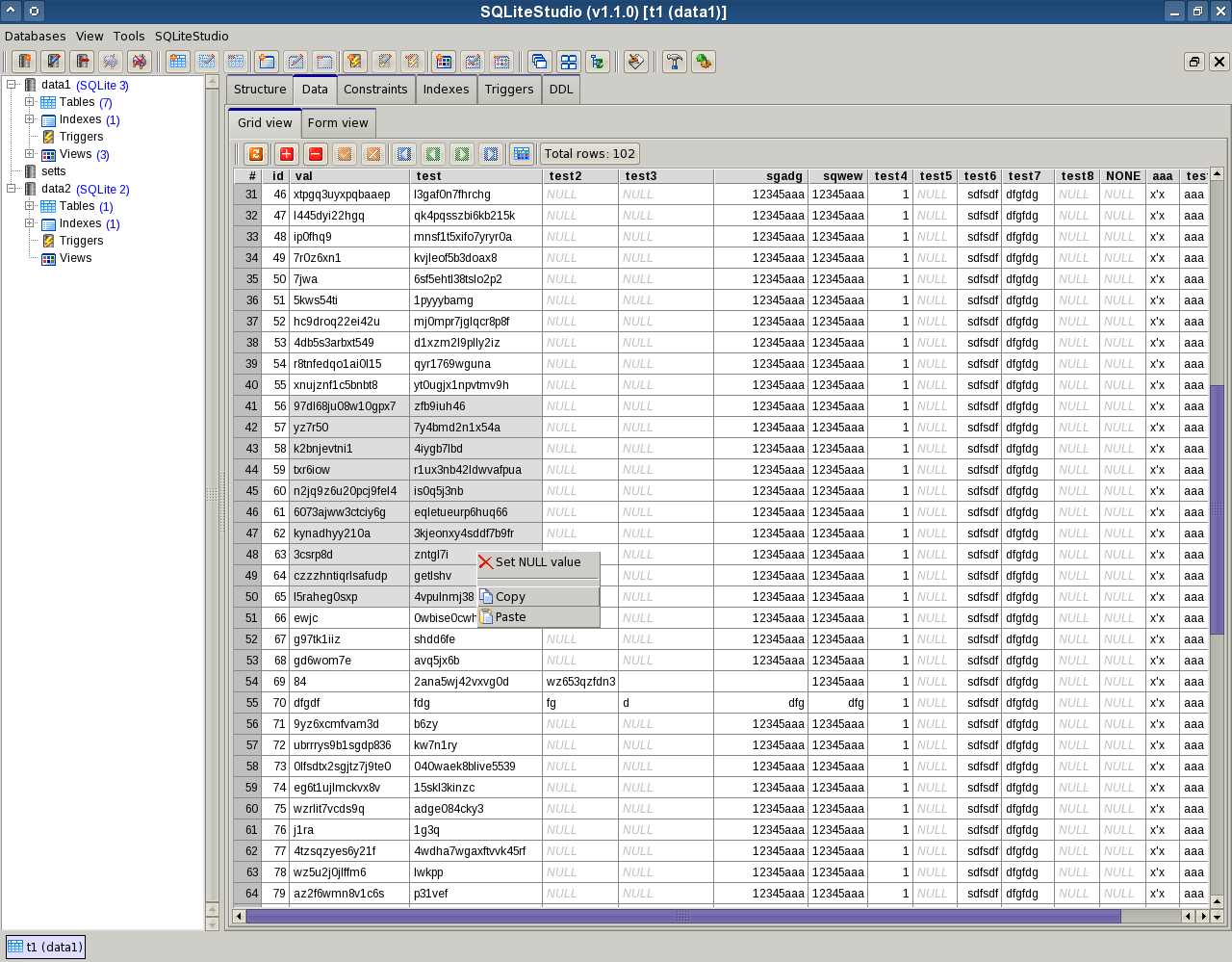

- SQLITESTUDIO VS DB BROWSER FOR SQLITE MAC OS X
- SQLITESTUDIO VS DB BROWSER FOR SQLITE UPDATE
- SQLITESTUDIO VS DB BROWSER FOR SQLITE CODE
- SQLITESTUDIO VS DB BROWSER FOR SQLITE WINDOWS
memory database file size + small overhead. In case of in-memory database store, your application wil consume. And as you said, it's persistent data storage. Thanks to the dedicated efforts of mgrojo, our nightly builds now include a Dark style theme courtesy of the QDarkStyleSheet project: To activate it, choose Dark style from the Application Style dropdown in PreferencesGeneral: To turn it off, choose Follow the desktop style. When SQLite work with on-disk database, there is no memory overhead because of it, it don't even meter size of the file (by default database can hold about 1Tb of data in it's tables). ** This function returns a pointer to a buffer containing the encrypted Dark theme support in our nightly builds. ** This function is called by the wal module when writing page content It is the most widely deployed database engine, as it is used by several of the top web browsers.
SQLITESTUDIO VS DB BROWSER FOR SQLITE CODE
Sample code below (original SQLite source): #ifdef SQLITE_HAS_CODEC As such, it belongs to the family of embedded databases. You need to define SQLITE_HAS_CODEC=1 to enable Pager encryption. This means, that on top of existing code one can easily develop some encryption mechanism, does not have to be AES.

However SQLite has interface built-in for encryption (Pager). SQLiteConnection conn = new SQLiteConnection("Data Source=" + filename + " Version=3 Password=" + passwordString + " ") string filename = passwordString = "password" SQLiteStudio is very similar to DB Browser for SQLite. It has been mentiond 183 times since March 2021.
SQLITESTUDIO VS DB BROWSER FOR SQLITE UPDATE
To decrypt, it's just a matter of putting the password in your connection string before the call to open. It runs on Windows, Mac and Linux with a more polished user interface and a higher update frequency. Based on our record, DB Browser for SQLite should be more popular than SQLiteStudio. Optionally, you can remove conn.SetPassword(passwordBytes), and replace it with conn.ChangePassword("password") which needs to be placed after conn.Open() instead of before. SqlCmd = new SQLiteCommand("INSERT INTO data VALUES('name', 'path', 200, 'dir')", conn) īyte bytes = new byte īytes = .GetBytes(str) SQLiteCommand sqlCmd = new SQLiteCommand("CREATE TABLE data(filename TEXT, filepath TEXT, filelength INTEGER, directory TEXT)", conn) SQLiteConnection conn = new SQLiteConnection("Data Source=" + connectionString + " Version=3 ") SQLiteConnection.CreateFile(connectionString) String connectionString = passwordString = "password" īyte passwordBytes = GetBytes(passwordString) Our latest release (3.12. Nightly builds often fix bugs reported after the last release.
SQLITESTUDIO VS DB BROWSER FOR SQLITE WINDOWS
This will create the DB, encrypt it, create a table, and add data. DB Browser for SQLite - PortableApp Note - If for any reason the standard Windows release does not work (e.g.
SQLITESTUDIO VS DB BROWSER FOR SQLITE MAC OS X
In the questionWhat are the best Mac OS X GUIs for SQLite DB Browser for SQLite is ranked 3rd while SQLiteFlow is ranked 5th. I'm only using it for my own course of study. When comparing DB Browser for SQLite vs SQLiteFlow, the Slant community recommends DB Browser for SQLite for most people. I don't know how much protection this provides. This feature allows the code for extensions to be developed and tested separately from the application and then loaded on an as. If it is not working, go back to the hard drive.Keep in mind, the following is not intended to be a substitute for a proper security solution.Īfter playing around with this for four days, I've put together a solution using only the open source package from NuGet. SQLite has the ability to load extensions (including new application-defined SQL functions, collating sequences, virtual tables, and VFSes) at run-time. If you aren't sure, try loading everything into memory and see if you have problems on your server during periods of heavy load. Your choice should be based on the needs and specs of the system you are operating on. You will have better real world performance under very high loads (assuming you can accomodate the memory usage), but a much higher memory footprint. On the other hand, if you keep everything loaded into memory, it will have a much higher memory footprint, compensated by a much faster database access time. The downside to this is slower access times, translating to decreased real world performance under very heavy loads. If you keep everything on the file system, this will save memory because you don't have to have everything loaded (into memory) at once, and even when something is loaded it quickly closes. Basically, if you keep it on the local file system and load it into memory on demand, this will always have a lower (or equal) memory footprint than if you have ALL data loaded into memory at all times.


 0 kommentar(er)
0 kommentar(er)
